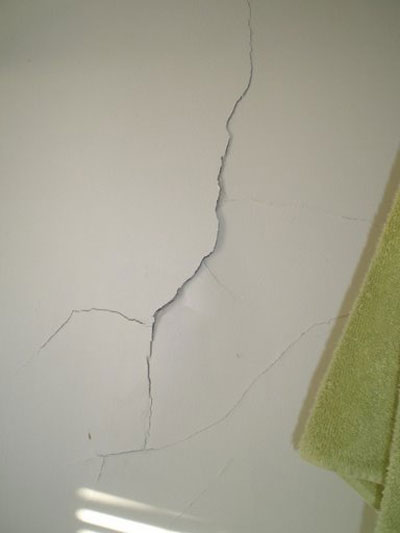Crack In Plaster Wall

Do cracks in my walls indicate a structural problem? -Rachel Most small cracks in drywall or plaster walls are not serious and are caused by seasonal expansion and contraction of the wood framing in your house over time. They’re often found at the corners of window and door frames, and can be patched using spackling or joint compound. Larger cracks in your walls, however, can indicate structural or foundation problems. If the cracks in your walls exhibit these characteristics: • The crack has a 3/16” or wider gap. • One side of the wall is higher than the other. • Your doors no longer close in the frame.
Older homes often have lath-and-plaster walls. Plaster is both a durable and good-looking surface, but there is one drawback: Plaster inevitably develops cracks. Large cracks, where the lath and plaster have been pulled away from the wall, can be re-secured using metal plaster washers and ordinary 1-1/2' or 2' drywall screws (Image 1). This secures the existing plaster to the wood lath. Secure screws and washers diagonally on either side of loose plaster, about 1-1/2' to 2' from the crack (Image 2).
You may have a structural problem and should have your house examined by a foundation specialist. Watch this video to find out more. Further Information • (video) • (video) • (video) • (article). Rachel Asks: I’m seeing a lot of small cracks in my walls. Do I have a structural problem?
Danny Lipford: It’s very unlikely that those small, hairline cracks that you see on the walls in your home, maybe above doors and windows, are actual structural problems. It’s usually just a little thermal expansion that can be repaired very easily by just using a little lightweight spackling. But the type of crack you really need to be concerned with are those that are little wider than that, maybe three-sixteenth of an inch or more, and where one side of the crack is not level with the other side of the crack. That can indicate some active structural movement. Also, if you have any doors in your home that don’t fit the jams quite as well as they used to, another tell-tale sign. Either of those situations you need to call out a foundation specialist and allow them to look very closely at that area of your home. My husband and I just bought a historical home built in 1883, it has a beautiful stairwell going to a mid point with a bathroom then right up 5 more stairs to upstairs bedrooms.
I noticed a crack in the wall extending from upstairs guest room running horizontally along stair well. The previous owners took down all of the original wallpaper and the walls are made from extremely hard spackle. This crack bulges out and I think it is just the spackle. We had the home inspected before we bought it for any structural issues and they did not find any.
Any advise on fixing this crack?? • Rebecca Says. I just elevated my home due to super storm sandy and onceI was able to get in the house we noticed the bathroom door came off its hinges and that the tub also moved, kitchen counters moved out about 1/4 inch.
There are many cracks throughout the house which is over 100 years old but was just totally redone after hurricane Sandy. My home lifter and contractor say its nothing but I had a roofing and siding contractor in and he suggested i get a structural engineer due to the rather large new crack in the kitchen ceiling which he said was not water damage more stress related. Any advice would be greatly appreciated I just spent alot of money on a foundation and lift to put this house back together. Thanks • Cheryl Says. New house built only 10 months old. Exterior outside my house near the bedroom window has a long line crack that goes straight down from the corner of the window then makes a line turning left then goes back down.
Tapout Exercise Program more. I have the same problem outside in my backroom window. Please advice, My carpet in my bdrm window is wet like if I had spilled something and the baseboard on the top edge looks like its unglued with bits of the paint on top of the baseboard separting from the wall. We just had hurricane Irma when I noticed this issue.
• Averil Hislop Says. My house was built in 1953 and a small one room addition was built in 2009. We’ve lived here for one year and after a few months of denial; I’m ready to admit we have significant cracks in the wall of our addition. It must’ve been built on a slab (no crawl space). The cracks are mostly on one wall, they are vertical and horizontal. The widest cracks are in line with a window frame. The corner of the room (shown in the picture) is cracked from the floor to ceiling.
There is one vertical crack on an adjacent wall. Sewer line was replaced just under addition prior to move in. Sewer guy claims he only removed dirt outside of the house, so a guy could get down in the hole.